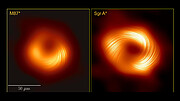Press Release
Astronomers unveil strong magnetic fields spiraling at the edge of Milky Way’s central black hole
27 March 2024
A new image from the Event Horizon Telescope (EHT) collaboration has uncovered strong and organised magnetic fields spiraling from the edge of the supermassive black hole Sagittarius A* (Sgr A*). Seen in polarised light for the first time, this new view of the monster lurking at the heart of the Milky Way galaxy has revealed a magnetic field structure strikingly similar to that of the black hole at the centre of the M87 galaxy, suggesting that strong magnetic fields may be common to all black holes. This similarity also hints toward a hidden jet in Sgr A*. The results were published today in The Astrophysical Journal Letters.
In 2022 scientists unveiled the first image of Sgr A* at press conferences around the world, including at the European Southern Observatory (ESO). While the Milky Way’s supermassive black hole, which is roughly 27 000 light-years away from Earth, is more than a thousand times smaller and less massive than M87’s, the first-ever black hole imaged, the observations revealed that the two look remarkably similar. This made scientists wonder whether the two shared common traits outside of their looks. To find out, the team decided to study Sgr A* in polarised light. Previous studies of light around the M87 black hole (M87*) revealed that the magnetic fields around it allowed the black hole to launch powerful jets of material back into the surrounding environment. Building on this work, the new images have revealed that the same may be true for Sgr A*.
“What we’re seeing now is that there are strong, twisted, and organised magnetic fields near the black hole at the centre of the Milky Way galaxy,” said Sara Issaoun, NASA Hubble Fellowship Program Einstein Fellow at the Center for Astrophysics | Harvard & Smithsonian, US, and co-lead of the project. “Along with Sgr A* having a strikingly similar polarisation structure to that seen in the much larger and more powerful M87* black hole, we’ve learned that strong and ordered magnetic fields are critical to how black holes interact with the gas and matter around them.”
Light is an oscillating, or moving, electromagnetic wave that allows us to see objects. Sometimes, light oscillates in a preferred orientation, and we call it ‘polarised’. Although polarised light surrounds us, to human eyes it is indistinguishable from ‘normal’ light. In the plasma around these black holes, particles whirling around magnetic field lines impart a polarisation pattern perpendicular to the field. This allows astronomers to see in increasingly vivid detail what’s happening in black hole regions and map their magnetic field lines.
“By imaging polarised light from hot glowing gas near black holes, we are directly inferring the structure and strength of the magnetic fields that thread the flow of gas and matter that the black hole feeds on and ejects,” said Harvard Black Hole Initiative Fellow and project co-lead Angelo Ricarte. “Polarised light teaches us a lot more about the astrophysics, the properties of the gas, and mechanisms that take place as a black hole feeds.”
But imaging black holes in polarised light isn’t as easy as putting on a pair of polarised sunglasses, and this is particularly true of Sgr A*, which is changing so fast that it doesn’t sit still for pictures. Imaging the supermassive black hole requires sophisticated tools above and beyond those previously used for capturing M87*, a much steadier target. EHT Project Scientist Geoffrey Bower from the Institute of Astronomy and Astrophysics, Academia Sinica, Taipei said, “Because Sgr A* moves around while we try to take its picture, it was difficult to construct even the unpolarised image,” adding that the first image was an average of multiple images owing to Sgr A*’s movement. “We were relieved that polarised imaging was even possible. Some models were far too scrambled and turbulent to construct a polarised image, but Nature was not so cruel.”
Mariafelicia De Laurentis, EHT Deputy Project Scientist and professor at the University of Naples Federico II, Italy, said, “With a sample of two black holes — with very different masses and very different host galaxies — it’s important to determine what they agree and disagree on. Since both are pointing us toward strong magnetic fields, it suggests that this may be a universal and perhaps fundamental feature of these kinds of systems. One of the similarities between these two black holes might be a jet, but while we’ve imaged a very obvious one in M87*, we’ve yet to find one in Sgr A*.”
To observe Sgr A*, the collaboration linked eight telescopes around the world to create a virtual Earth-sized telescope, the EHT. The Atacama Large Millimeter/submillimeter Array (ALMA), in which ESO is a partner, and the ESO-hosted Atacama Pathfinder Experiment (APEX), both in northern Chile, were part of the network that made the observations, conducted in 2017.
"As the largest and most powerful of the telescopes in the EHT, ALMA played a key role in making this image possible,” says ESO’s María Díaz Trigo, European ALMA Programme Scientist. “ALMA is now planning an ‘extreme makeover’, the Wideband Sensitivity Upgrade, which will make ALMA even more sensitive and keep it a fundamental player in future EHT observations of Sgr A* and other black holes."
The EHT has conducted several observations since 2017 and is scheduled to observe Sgr A* again in April 2024. Each year, the images improve as the EHT incorporates new telescopes, larger bandwidth, and new observing frequencies. Planned expansions for the next decade will enable high-fidelity movies of Sgr A*, may reveal a hidden jet, and could allow astronomers to observe similar polarisation features in other black holes. Meanwhile, extending the EHT into space would provide sharper images of black holes than ever before.
More information
This research was presented in two papers by the EHT Collaboration published today in The Astrophysical Journal Letters: "First Sagittarius A* Event Horizon Telescope Results. VII. Polarization of the Ring" (doi:10.3847/2041-8213/ad2df0
) and "First Sagittarius A* Event Horizon Telescope Results. VIII.: Physical interpretation of the polarized ring" (doi:10.3847/2041-8213/ad2df1
).
The EHT collaboration involves more than 300 researchers from Africa, Asia, Europe, and North and South America. The international collaboration is working to capture the most detailed black hole images ever obtained by creating a virtual Earth-sized telescope. Supported by considerable international investment, the EHT links existing telescopes using novel systems — creating a fundamentally new instrument with the highest angular resolving power that has yet been achieved.
The individual telescopes involved in the EHT in April 2017, when the observations were conducted, were: the Atacama Large Millimeter/submillimeter Array (ALMA), the Atacama Pathfinder EXperiment (APEX), the Institut de Radioastronomie Millimetrique (IRAM) 30-meter Telescope, the James Clerk Maxwell Telescope (JCMT), the Large Millimeter Telescope Alfonso Serrano (LMT), the Submillimeter Array (SMA), the UArizona Submillimeter Telescope (SMT), and the South Pole Telescope (SPT). Since then, the EHT has added the Greenland Telescope (GLT), the IRAM NOrthern Extended Millimeter Array (NOEMA) and the UArizona 12-meter Telescope on Kitt Peak to its network.
The EHT consortium consists of 13 stakeholder institutes: the Academia Sinica Institute of Astronomy and Astrophysics, the University of Arizona, the University of Chicago, the East Asian Observatory, Goethe-Universitaet Frankfurt, Institut de Radioastronomie Millimétrique, Large Millimeter Telescope, Max Planck Institute for Radio Astronomy, MIT Haystack Observatory, National Astronomical Observatory of Japan, Perimeter Institute for Theoretical Physics, Radboud University and the Smithsonian Astrophysical Observatory.
The Atacama Large Millimeter/submillimeter Array (ALMA), an international astronomy facility, is a partnership of ESO, the U.S. National Science Foundation (NSF) and the National Institutes of Natural Sciences (NINS) of Japan in cooperation with the Republic of Chile. ALMA is funded by ESO on behalf of its Member States, by NSF in cooperation with the National Research Council of Canada (NRC) and the National Science and Technology Council (NSTC) in Taiwan and by NINS in cooperation with the Academia Sinica (AS) in Taiwan and the Korea Astronomy and Space Science Institute (KASI). ALMA construction and operations are led by ESO on behalf of its Member States; by the National Radio Astronomy Observatory (NRAO), managed by Associated Universities, Inc. (AUI), on behalf of North America; and by the National Astronomical Observatory of Japan (NAOJ) on behalf of East Asia. The Joint ALMA Observatory (JAO) provides the unified leadership and management of the construction, commissioning and operation of ALMA.
Links
- Research paper VII
- Research paper VIII
- Photos of ALMA
- Photos of APEX
- ESO EHT Milky Way page (focusing on the previous Sgr A* results)
- For journalists: subscribe to receive our releases under embargo in your language
- For scientists: got a story? Pitch your research
Contacts
Sara Issaoun
Center for Astrophysics | Harvard & Smithsonian
USA
Email: sara.issaoun@cfa.harvard.edu
Angelo Ricarte
Center for Astrophysics | Harvard & Smithsonian
USA
Email: angelo.ricarte@cfa.harvard.edu
Geoffrey Bower
EHT Project Scientist
Institute of Astronomy and Astrophysics, Academic Sinica, Taiwan
Email: gbower@asiaa.sinica.edu.tw
Mariafelicia De Laurentis
EHT Deputy Project Scientist, University of Naples Federico II
Italy
Email: mariafelicia.delaurentis@unina.it
María Diaz Trigo
ALMA Programme Scientist, European Southern Observatory
Garching bei München, Germany
Email: mdiaztri@eso.org
Bárbara Ferreira
ESO Media Manager
Garching bei München, Germany
Tel: +49 89 3200 6670
Cell: +49 151 241 664 00
Email: press@eso.org
About the Release
| Release No.: | eso2406 |
| Name: | Sagittarius A* |
| Type: | Milky Way : Galaxy : Component : Central Black Hole |
| Facility: | Atacama Large Millimeter/submillimeter Array |
| Science data: | 2024ApJ...964L..26E 2024ApJ...964L..25E |
Our use of Cookies
We use cookies that are essential for accessing our websites and using our services. We also use cookies to analyse, measure and improve our websites’ performance, to enable content sharing via social media and to display media content hosted on third-party platforms.
ESO Cookies Policy
The European Organisation for Astronomical Research in the Southern Hemisphere (ESO) is the pre-eminent intergovernmental science and technology organisation in astronomy. It carries out an ambitious programme focused on the design, construction and operation of powerful ground-based observing facilities for astronomy.
This Cookies Policy is intended to provide clarity by outlining the cookies used on the ESO public websites, their functions, the options you have for controlling them, and the ways you can contact us for additional details.
What are cookies?
Cookies are small pieces of data stored on your device by websites you visit. They serve various purposes, such as remembering login credentials and preferences and enhance your browsing experience.
Categories of cookies we use
Essential cookies (always active): These cookies are strictly necessary for the proper functioning of our website. Without these cookies, the website cannot operate correctly, and certain services, such as logging in or accessing secure areas, may not be available; because they are essential for the website’s operation, they cannot be disabled.
Functional Cookies: These cookies enhance your browsing experience by enabling additional features and personalization, such as remembering your preferences and settings. While not strictly necessary for the website to function, they improve usability and convenience; these cookies are only placed if you provide your consent.
Analytics cookies: These cookies collect information about how visitors interact with our website, such as which pages are visited most often and how users navigate the site. This data helps us improve website performance, optimize content, and enhance the user experience; these cookies are only placed if you provide your consent. We use the following analytics cookies.
Matomo Cookies:
This website uses Matomo (formerly Piwik), an open source software which enables the statistical analysis of website visits. Matomo uses cookies (text files) which are saved on your computer and which allow us to analyze how you use our website. The website user information generated by the cookies will only be saved on the servers of our IT Department. We use this information to analyze www.eso.org visits and to prepare reports on website activities. These data will not be disclosed to third parties.
On behalf of ESO, Matomo will use this information for the purpose of evaluating your use of the website, compiling reports on website activity and providing other services relating to website activity and internet usage.
Matomo cookies settings:
Additional Third-party cookies on ESO websites: some of our pages display content from external providers, e.g. YouTube.
Such third-party services are outside of ESO control and may, at any time, change their terms of service, use of cookies, etc.
YouTube: Some videos on the ESO website are embedded from ESO’s official YouTube channel. We have enabled YouTube’s privacy-enhanced mode, meaning that no cookies are set unless the user actively clicks on the video to play it. Additionally, in this mode, YouTube does not store any personally identifiable cookie data for embedded video playbacks. For more details, please refer to YouTube’s embedding videos information page.
Cookies can also be classified based on the following elements.
Regarding the domain, there are:
- First-party cookies, set by the website you are currently visiting. They are stored by the same domain that you are browsing and are used to enhance your experience on that site;
- Third-party cookies, set by a domain other than the one you are currently visiting.
As for their duration, cookies can be:
- Browser-session cookies, which are deleted when the user closes the browser;
- Stored cookies, which stay on the user's device for a predetermined period of time.
How to manage cookies
Cookie settings: You can modify your cookie choices for the ESO webpages at any time by clicking on the link Cookie settings at the bottom of any page.
In your browser: If you wish to delete cookies or instruct your browser to delete or block cookies by default, please visit the help pages of your browser:
Please be aware that if you delete or decline cookies, certain functionalities of our website may be not be available and your browsing experience may be affected.
You can set most browsers to prevent any cookies being placed on your device, but you may then have to manually adjust some preferences every time you visit a site/page. And some services and functionalities may not work properly at all (e.g. profile logging-in, shop check out).
Updates to the ESO Cookies Policy
The ESO Cookies Policy may be subject to future updates, which will be made available on this page.
Additional information
For any queries related to cookies, please contact: pdprATesoDOTorg.
As ESO public webpages are managed by our Department of Communication, your questions will be dealt with the support of the said Department.










